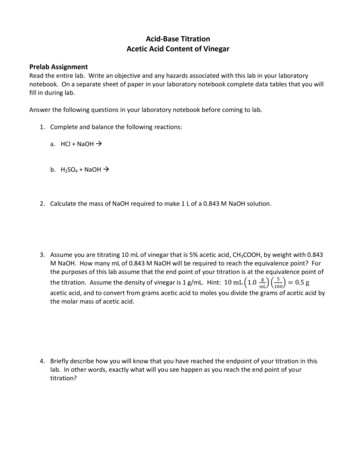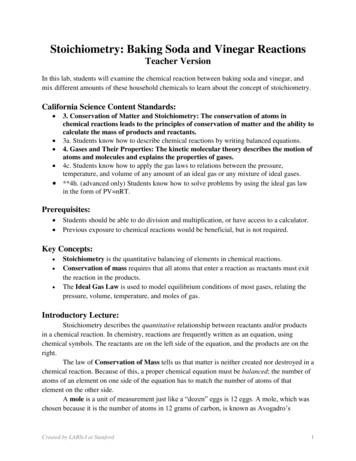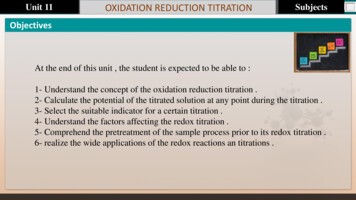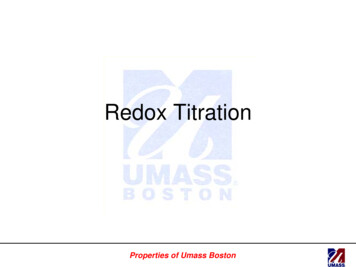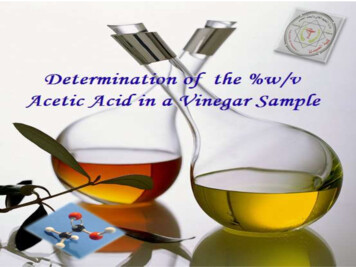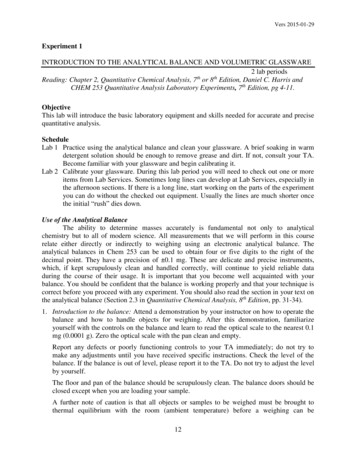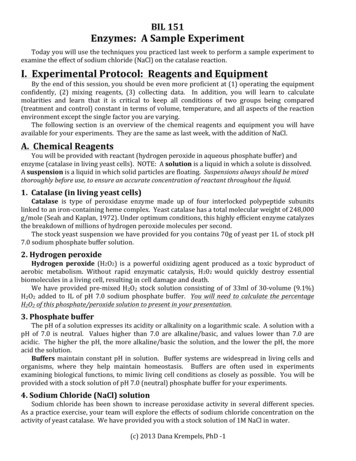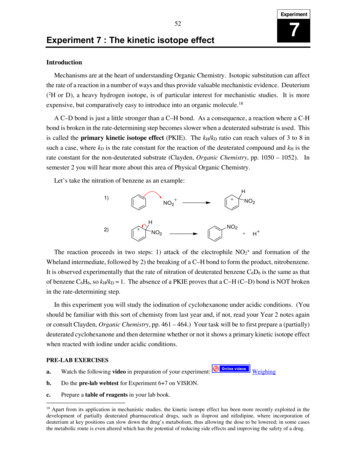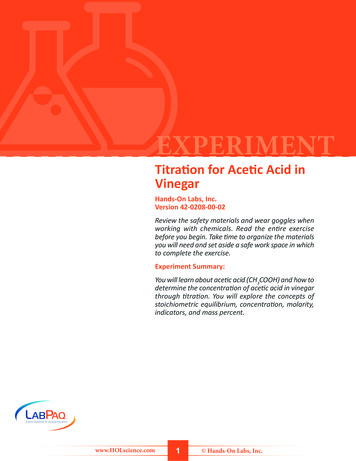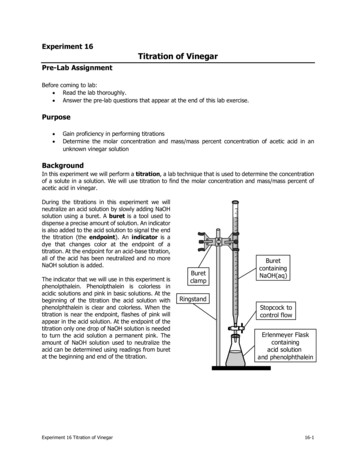
Transcription
Experiment 16Titration of VinegarPre-Lab AssignmentBefore coming to lab: Read the lab thoroughly. Answer the pre-lab questions that appear at the end of this lab exercise.Purpose Gain proficiency in performing titrationsDetermine the molar concentration and mass/mass percent concentration of acetic acid in anunknown vinegar solutionBackgroundIn this experiment we will perform a titration, a lab technique that is used to determine the concentrationof a solute in a solution. We will use titration to find the molar concentration and mass/mass percent ofacetic acid in vinegar.During the titrations in this experiment we willneutralize an acid solution by slowly adding NaOHsolution using a buret. A buret is a tool used todispense a precise amount of solution. An indicatoris also added to the acid solution to signal the endthe titration (the endpoint). An indicator is adye that changes color at the endpoint of atitration. At the endpoint for an acid-base titration,all of the acid has been neutralized and no moreNaOH solution is added.The indicator that we will use in this experiment isphenolpthalein. Phenolpthalein is colorless inacidic solutions and pink in basic solutions. At thebeginning of the titration the acid solution withphenolphthalein is clear and colorless. When thetitration is near the endpoint, flashes of pink willappear in the acid solution. At the endpoint of thetitration only one drop of NaOH solution is neededto turn the acid solution a permanent pink. Theamount of NaOH solution used to neutralize theacid can be determined using readings from buretat the beginning and end of the titration.Experiment 16 Titration of topcock tocontrol flowErlenmeyer Flaskcontainingacid solutionand phenolphthalein16-1
Reading a BuretBurets are designed to deliver precise volumes of liquids. Each marking on the buret represents 0.1mL, so volume readings must be estimated to the nearest 0.01 mL (all reported volumes must havetwo decimal places). Note that the zero mark is at the top of the buret instead of at the bottom andthat the numbers increase as you move down the buret (this is the opposite of a graduated cylinder).Make sure your eye is level with the meniscus and take the reading from the bottom of the meniscus.Examples are shown below.Initial Buret Reading0mL1mLFinal Buret Reading31mLCORRECT:0.00 mL JINCORRECT:0 mL L0.0 mL LCORRECT:31.93 mL JINCORRECT:32 32.07 mL LmLThe total volume of liquid dispensed from the buret is calculated as:final buret reading – initial buret reading 31.93 mL – 0.00 mL 31.93 mLIn Part A we will prepare and standardize a solution of NaOH. Standardization is process of determiningthe exact concentration of a solution by titration. The exact concentration of the NaOH solution will bedetermined by titrating a solution containing a known amount of potassium hydrogen phthalate(abbreviated KHP) dissolved in water. The balanced equation for the reaction between KHP and NaOH isshown below:KHC8H4O4(aq)(KHP) NaOH(aq) KNaC8H4O4(aq) H2O(ℓ)By knowing the volume of NaOH solution dispensed from the buret and the mass of KHP used, we cancalculate the molarity of the NaOH solution. A sample calculation to determine the molarity of NaOH isshown in Example 1.Experiment 16 Titration of Vinegar16-2
Example Problem 1: Molarity of Standardized NaOHA 0.9341 g sample of KHP (204.23 g/mol) is dissolved in water and titrated with 20.61 mL of NaOHsolution. Calculate the molarity of the NaOH solution.KHC8H4O4(aq)(KHP) NaOH(aq) KNaC8H4O4(aq) H2O(ℓ)Step 1: Convert grams of KHP to moles of NaOH using the balanced equation for the reaction of KHPwith NaOH.0.9341 g )1 mol KHP1 mol NaOH1)1 0.004574 mol NaOH204.23 g KHP 1 mol KHPStep 2: Convert mL of NaOH solution given in the problem to L of NaOH. Use the moles of NaOH fromStep 1 and L of NaOH to calculate the molarity of NaOH (mol/L).1L20.61 mL NaOH solution )1 0.02061 L NaOH solution1000 mL0.004574 mol NaOHmol NaOH 0.2219 0.2219 M NaOH0.02061 L NaOH solutionL solutionIn this example, the concentration of NaOH is 0.2219 M.In Part B we will use the standardized NaOH from Part A to determine the concentration of acetic acid in avinegar solution. The balanced equation for the neutralization reaction between acetic acid and NaOH isshown below.HC2H3O2(aq)(acetic acid) NaOH(aq) NaC2H3O2(aq) H2O(ℓ)By knowing the volume and molarity of the NaOH dispensed from the buret and the volume of vinegarsolution, we can determine the molarity of acetic acid in vinegar. The molarity of acetic acid can beconverted to the mass/mass percent concentration using the density of the vinegar (1.01 g/mL) and themolar mass of acetic acid (60.06 g/mol). A sample calculation for calculating the molarity and mass/masspercent of acetic acid in vinegar is shown in Example 2.Experiment 16 Titration of Vinegar16-3
Example Problem 2: Molarity and mass/mass percent of acetic acid in vinegarThe titration of 10.00 mL of vinegar requires 31.93 mL of 0.2219 M NaOH to reach the endpoint.Calculate the molarity and mass/mass percent of acetic acid in the vinegar.HC2H3O2(aq)(acetic acid) NaOH(aq) NaC2H3O2(aq) H2O(ℓ)Step 1: Convert the volume of NaOH solution to moles of HC2H3O2 using the molarity of NaOH and thebalanced equation for the reaction of HC2H3O2and NaOH.1 L NaOH0.2219 mol NaOH 1 mol HCA HB OA31.91 mL NaOH )1)1)11000 mL NaOH1 L NaOH1 mol NaOH 0.007085 mol HCA HB OAStep 2: Use the moles of HC2H3O2 from Step 1 and L of vinegar to calculate the molarity of HC2H3O2(mol/L).1L10.00 mL vinegar solution )1 0.01000 L vinegar solution1000 mL0.007085 mol HCA HB OAmol HCA HB OA 0.7081 0.7085 M HCA HB OA0.01000 L vinegar solutionL solutionStep 3: Use the density of the vinegar (1.01 g/mL) and the molar mass of acetic acid (60.06 g/mol) toconvert the molarity of HC2H3O2 to mass/mass %.0.7085 mol HCA HB OA1L60.06 g HCA HB OA 1 mL vinegar solution)1)1)1 100%1L vinegar solution 1000 mL1 mol HCA HB OA1.01 g vinegar solution 4.21 m/m% HCA HB OAIn this example, the concentration of HC2H3O2 in vinegar is 0.2219 M or 4.21 m/m %.Experiment 16 Titration of Vinegar16-4
ProcedurePart A: Standardization of NaOH SolutionSafety: Wear safety googles at all times.If you come into contact with 6.0 M NaOH, wash the area effected immediately with water.1. Obtain the following equipment from the side counters or the instructor’s desk:50-mL buret10-mL volumetric pipettepipette bulbringstand with buret clamp2. Take out a 250-mL beaker from your drawer and use a pencil to label it as your temporary wastecontainer on the large white marking spot.Preparing the KHP solutions3. Label two 125-mL Erlenmeyer flasks as #1 and #2 on the white marking spot. Add about 1 g ofsolid KHP to each flask, making sure to record the exact masses of KHP used on your reportsheet. Add about 25 mL of DI water using a graduated cylinder and 2-3 drops of phenolphthaleinindicator to each flask and swirl to dissolve the KHP. If the KHP does not dissolve, it may benecessary to heat the flask slightly on a hot plate to insure the KHP dissolves.Preparing the NaOH solution4. Fill a 500 mL Florence flask about halfway with DI water (about 250 mL). Use a graduatedcylinder to measure out and add 20 mL of 6 M NaOH to the Florence flask. Seal the flask with arubber stopper and gently swirl to mix the solution.Preparing the buret5. Close the stopcock on the buret and use a funnel to pour about 10 mL of NaOH solution into theburet. Remove the funnel and gently tilt the buret on its side and roll the liquid around to rinsethe entire inner surface. Allow some of the NaOH solution to drain out through the tip into thewaste beaker at your station. Flip over the buret and pour the remaining NaOH rinse into yourwaste beaker. Repeat this step a second time.6. Place the empty buret in the buret clamp on your ringstand. Put the ringstand in the nearest sinkso that the top of the buret is near eye level. Check that the stopcock on the buret is closed. Fillthe buret with NaOH solution to just above the 0.00-mL mark. Use a funnel and pour very slowly!7. Place the Florence flask containing the NaOH under the buret. Open the stopcock slowly and letthe liquid level drop so that the bottom of the meniscus rests on the 0.00 mL mark. Make surethere are no air bubbles in the tip of the buret. Remove the buret and ringstand from the sinkIf you are having trouble removing air bubbles from the buret tip or the NaOH does not flow outof the buret in a steady stream, ask your instructor for help.Experiment 16 Titration of Vinegar16-5
8. Since the bottom of the meniscus of the NaOH in the buret is resting on the 0.00-mL mark,record 0.00 mL as the initial buret reading.Performing the titration9. Place the acid solution in the Erlenmeyer flask under the buret filled with base. Begin the titrationby slowly adding 1 mL base from the buret to the acid solution in the Erlenmeyer flask. Swirl theErlenmeyer flask after you add the base so the chemicals are well-mixed. Continue to add 1 mLportions of base to the flask, swirling after each addition. A small amount of pink may brieflyappear briefly in the flask when the base is added, but it will quickly disappear as the flask isswirled.10. As you approach the end of the titration, the pink color in the flask will take longer to disappear.When this happens, begin adding the NaOH solution drop by drop, swirling the flask afteradding each drop. Stop when the addition of just one drop of NaOH solution turns the solution inthe Erlenmeyer flask a pale pink color that does not disappear when the flask is swirled. Thisindicates that you have reached the endpoint of the titration.11. Use the bottom of the meniscus of the NaOH solution in the buret determine the final buretreading to two places past the decimal and record the value on your report sheet.12. Refill your buret with NaOH solution to 0.00-mL mark and repeat the titration for the secondsample of KHP.13. When you are finished with both titrations, dispose of your neutral pink solutions in the sink withplenty of water. Rinse out the flasks with DI water to reuse for part B.14. Calculate the molarity of the NaOH solution for each trial and the average molarity.Part B: Titration of Vinegar15. Obtain about 50 mL of vinegar in a clean, dry 100-mL beaker.16. Rinse the inside of the 10-mL volumetric pipette with vinegar. Use the pipette bulb to draw thevinegar into the pipette until the bulb is half-filled. Quickly remove the pipette bulb and placeyour finger on the top of the pipette to hold in the liquid. Gently the tilt the pipette to one sideand roll the liquid around to rinse the entire inner surface. Let the vinegar rinse drain out of thebottom of the pipette into your temporary waste beaker. Repeat this step one more time.17. Use the volumetric pipette to transfer 10.00-mL of vinegar to both of your labeled 125-mLErlenmeyer flasks. Your instructor will show you how to use the pipette. Don’t forget to makesure that the bottom of the meniscus is resting on the calibration mark and there are no airbubbles in the pipette before transferring the vinegar to the flask.Note: You can reuse your empty Erlenmeyer flasks from the titrations of KHP. You do notneed to dry the flasks before using them.18. Record 10.00 mL as the volume of vinegar on your report sheet for both samples. Then addabout 20 mL of DI water and 2 to 3 drops of phenolphthalein to the Erlenmeyer flask.19. Titrate the vinegar samples following steps 9-13 of this procedure (the same as you did for theKHP samples). Discard the pink solutions in the sink with plenty of water.Experiment 16 Titration of Vinegar16-6
20. Rinse the buret and volumetric pipette with DI water and return all titration equipment to theside counters and instructor’s desk.21. Empty your temporary waste beaker in the hazardous waste jug in the fumehood. Wash yourdirty glassware and return it to your drawer.22. Calculate the molarity and mass/mass percent of acetic acid in your vinegar sample.Experiment 16 Titration of Vinegar16-7
Experiment 16—Report SheetName:Part A: Standardization of NaOH SolutionTrial 1Trial 2Trial 31. Mass of Erlenmeyer flask KHP (g)2. Mass of Erlenmeyer flask (g)3. Mass of KHP (g)4. Final buret reading (mL)5. Initial buret reading (mL)6. Volume of NaOH used (mL)Show the calculation of the molarity of NaOH for Trial 1 (see Example 1).7. Molarity of NaOH (mol/L)8. Average molarity of NaOH (mol/L)Experiment 16 Titration of Vinegar16-8
Part B: Titration of VinegarAverage molarity of NaOH solution from Part A (mol/L)Trial 1Trial 2Trial 31. Volume of vinegar solution (mL)2. Final buret reading (mL)3. Initial buret reading (mL)4. Volume of NaOH used (mL)Show the calculation for the molarity of acetic acid for Trial 1. (See Example 2.)5. Molarity of HC2H3O2 (mol/L)6. Average molarity of HC2H3O2 (mol/L)Show the calculation for the mass/mass percent of acetic acid for Trial 1. Assume the density of vinegar is 1.01g/mL. (See Example 2.)7. Mass/mass percent HC2H3O2 (%)8. Average mass/mass percent HC2H3O2 (%)Experiment 16 Titration of Vinegar16-9
Experiment 16—Post-Lab Assignment.Name:1. Consider the possible sources of experimental error listed below. Circle the letter(s) of the errors thatwill NOT affect the final results of this experiment.a. The sodium hydroxide is not completely mixed with the water in the Florence flask.b. The buret is wet on the inside with water and is not rinsed with NaOH solution before it is filledwith NaOH and the titration is started.c.The KHP samples are dissolved in 50 mL of water instead of 25 mL of water.d. 5 drops of phenolphthalein are used instead of 2-3 drops.e. An air bubble that was trapped in the tip of the buret comes out during the titration.f.The Erlenmeyer flasks are not dried before the vinegar samples are prepared for titration.2. A 10.0-mL sample of household ammonia solution required 18.15 mL of 0.320 M HCl to be neutralized.HCl(aq) NH
Determine the molar concentration and mass/mass percent concentration of acetic acid in an unknown vinegar solution Background In this experiment we will perform a titration, a lab technique that is used to determine the concentration of a solute in a solution. We will use titration to find the molar concentration and mass/mass percent of acetic acid in vinegar. During the titrations in this experiment we willFile Size: 232KBPage Count: 13
